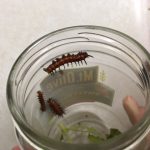
One of the roles of a Horticulture Extension Agent is to help identify pests found in the landscape. Weeds are fairly easy for people to sample, simply take some pictures or dig it up and bring it into the office, but what about insects?
Slow moving insects may be easy to photograph and if their size, shape, and coloration is very distinctive that may be enough for a good identification. But sometimes a photo isn’t worth a thousand words and the best way to get accurate identification is to bring in a physical sample.
The quality of the sample is going to either help or hinder with identification, so here are some tips:
- Never leave samples in a hot car – insects desiccate and become brittle in intense heat. Some details such as number of antennae segments or tarsi on legs are used to positively identify insects; missing pieces can lead to misidentification.
- Bring a live sample if it can be done safely and securely. Small, disposable plastic containers, jars with tightly sealing lids, and reused food or medicine containers work well.
- Small insects such as ants can be collected using a paintbrush dipped in rubbing alcohol which can then be swirled to release the ants into a vial/jar containing a small amount of alcohol. Small soft bodied insects can be collected this way, but may lose their color which may impede identification.
- Crushed or otherwise damaged samples should not be submitted.
- Limit samples to landscape or household pests – your local Extension Office is not a medical facility and is not equipped to handle or process samples that contain bodily fluids, skin scrapings, or similar materials. Please consult a physician for suspected human parasites.
Other helpful information that can be used for identification is the location of the insect, behavior (active night/day), and food source if known.
If insects must be mailed, please follow packaging directions found in this publication Insect Identification Service.
 0
0
